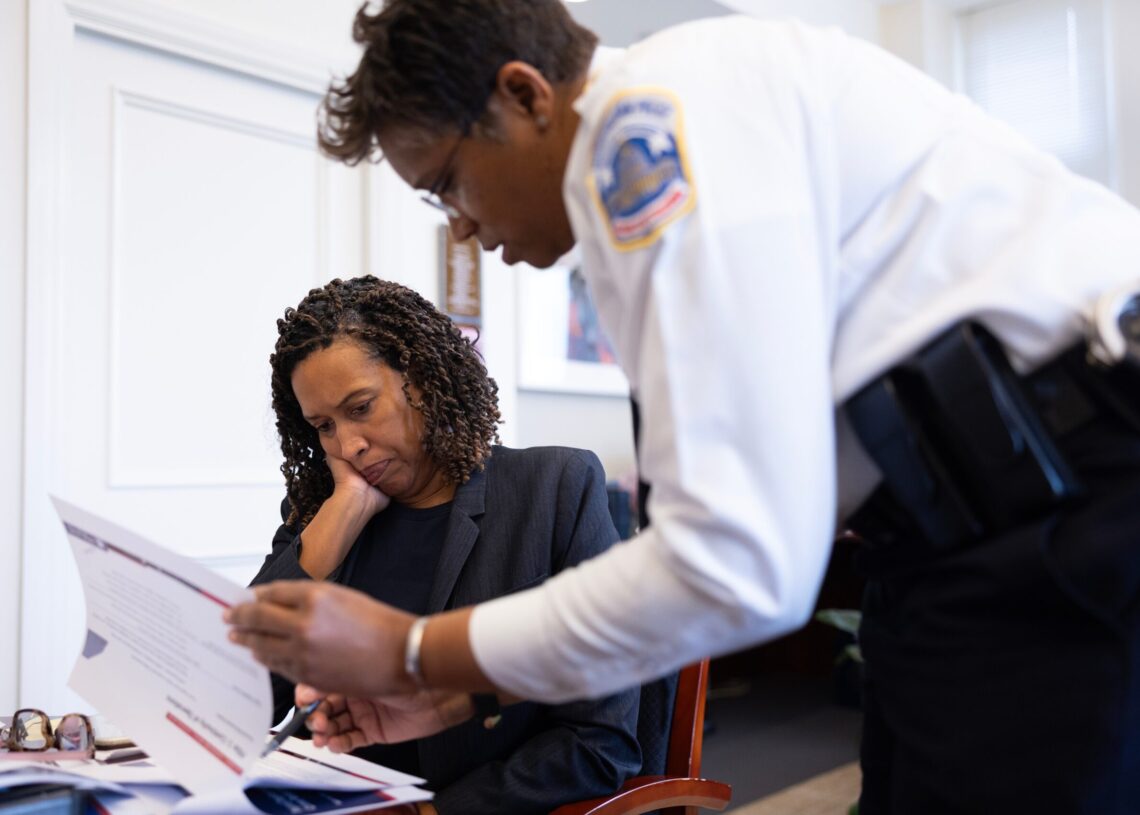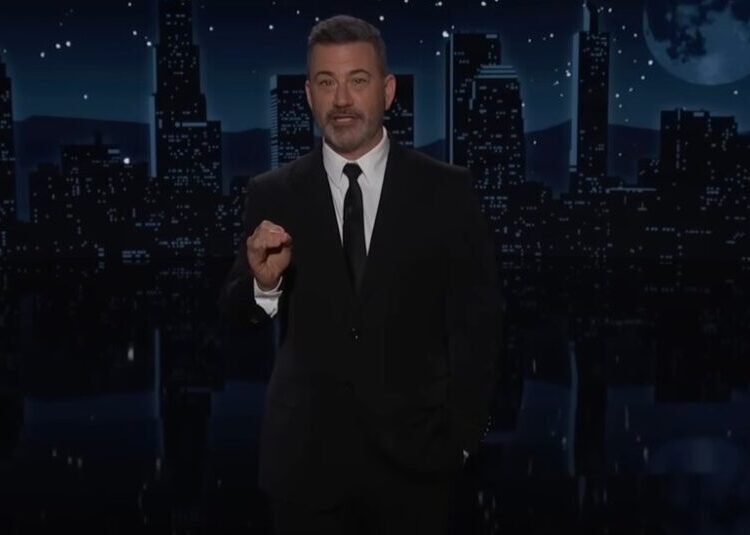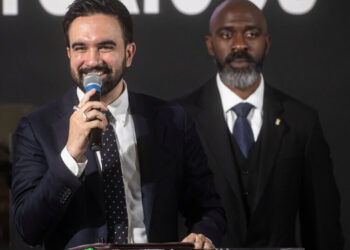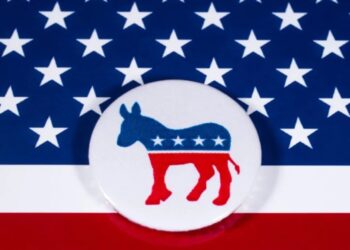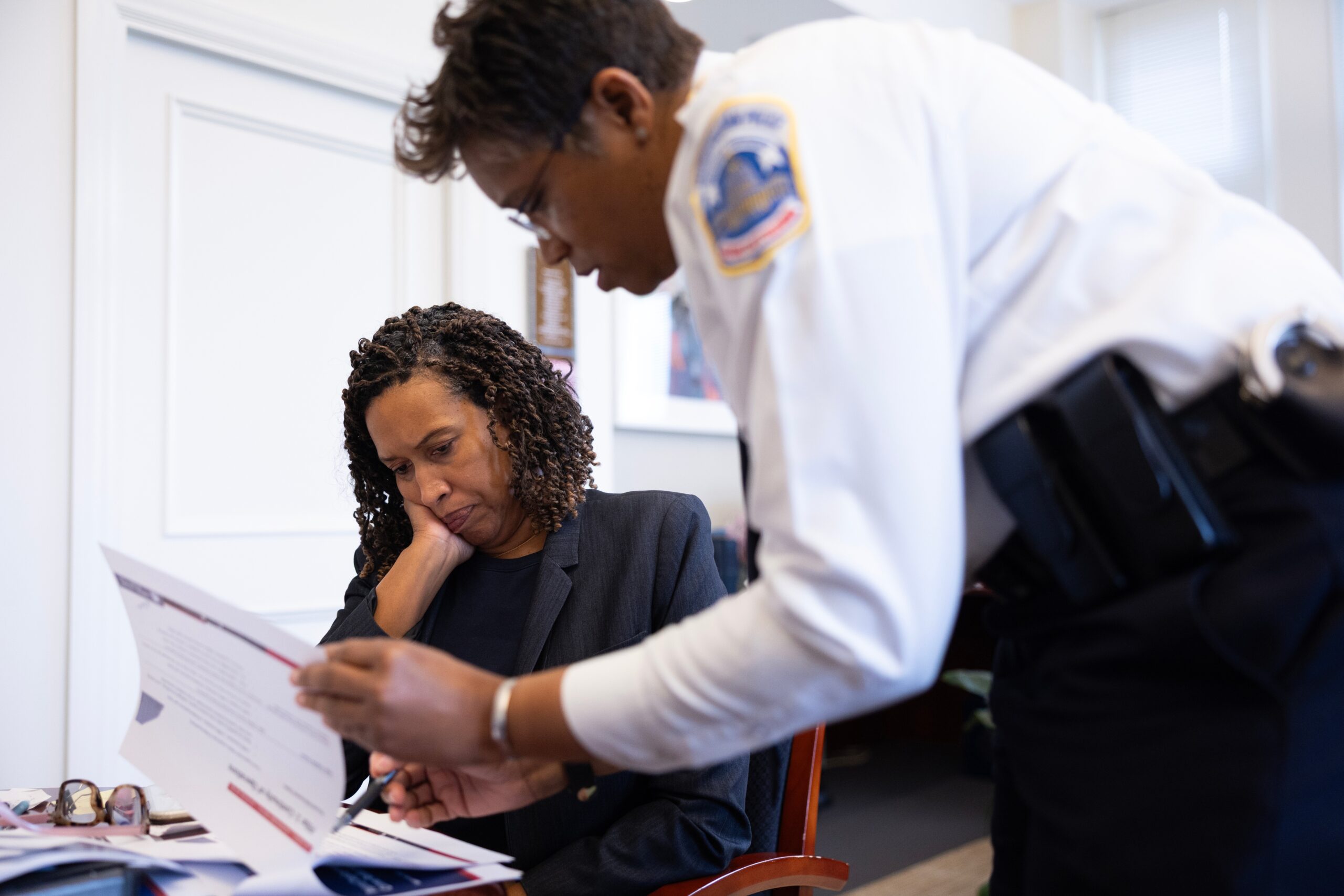
President-elect Donald Trump was complaining about grimy tiles.
It was December 2024, and D.C. Mayor Muriel E. Bowser had traveled to Mar-a-Lago to forge a working relationship with the man who had pledged during his campaign to wrest control of the city’s government upon his return to the White House.
In speeches, Trump had called D.C. a “horribly run” and “crime-ridden” city plagued by “filth and decay.” Now, with the mayor sitting across from him inside his office at his Palm Beach, Florida, club, he aired a more specific criticism: The tiles lining a highway tunnel under the National Mall were dirty and worn.
President-elect Donald Trump was complaining about grimy tiles.
It was December 2024, and D.C. Mayor Muriel E. Bowser had traveled to Mar-a-Lago to forge a working relationship with the man who had pledged during his campaign to wrest control of the city’s government upon his return to the White House.
In speeches, Trump had called D.C. a “horribly run” and “crime-ridden” city plagued by “filth and decay.” Now, with the mayor sitting across from him inside his office at his Palm Beach, Florida, club, he aired a more specific criticism: The tiles lining a highway tunnel under the National Mall were dirty and worn.
“Tiles are old/395 Tunnel,” Bowser (D) scribbled in green ink on the bottom-right corner of a sheet where she took color-coded notes during the wide-ranging, one-hour discussion.
Later that day, Bowser, whose defiant approach during Trump’s first term made her a national figure in the Democratic resistance, announced she’d had “a great meeting” with Trump about their “shared priorities.” Privately, she instructed her staff to inspect the Interstate 395 tunnel and find ways to brighten it up. Within weeks, city workers had switched on lights that had been left off to conserve energy and cleaned up their fixtures.
Bowser’s response was an early example of the approach she has used to so far prevent a complete federal takeover of the city, including her effort this summer to end an emergency order that gave the Trump administration control of D.C. police for 30 days. Behind the scenes, Bowser has worked to appease Trump in both small and significant ways — and more often than has been publicly known — in the year since his reelection, a Washington Post examination found.
This account, which reconstructs key interactions in the mayor’s effort to navigate Trump’s demands, is based on extensive interviews with Bowser and more than 20 other people, including Trump Chief of Staff Susie Wiles, who attended the Mar-a-Lago meeting. Bowser also allowed a Post reporter to accompany her during some events while Trump’s emergency order was in effect, to join meetings and phone calls with staff, and to review notes and internal memos.
Some of Bowser’s moves have been visible: Nearly two months into Trump’s presidency, for example, she ordered city workers to remove a ground mural in Black Lives Matter Plaza, a symbol of the racial justice protests that followed the murder of George Floyd in 2020.
But she has also been deferential out of the public eye. She assured Trump in an Oval Office meeting that she would publicly emphasize the benefits of his federal intervention. She worked to beautify city property that had drawn his attention. And she and her staff rubbed shoulders with the president and other administration officials at a closed-door White House gathering.
Bowser has thus far preserved D.C.’s limited self-governance, known as home rule.
At the same time, she has angered liberal constituents, and the limits of her strategy have come into focus since the emergency order expired in September. D.C. police are still working alongside federal immigration enforcement agents, and National Guard troops from red states are still patrolling the city.
Over the past several months, Trump has sent National Guard troops and federal law enforcement agents into Democratic-run cities across the country, prompting leaders in Chicago; Los Angeles; and Portland, Oregon, to forcefully reject the president’s actions as unwelcome and illegal.
Unlike those cities, D.C.’s unique constitutional status as a federal district makes it especially vulnerable to the kind of takeover Trump pledged while running for reelection. He raised that prospect during his private meeting with Bowser at Mar-a-Lago as he prepared to take office.
“You’ve been hearing about what I’ve been saying on the campaign trail about, you know, taking over,” Bowser recalled Trump telling her, an exchange confirmed by Wiles. “Do you think that would work?”
“I want to work with you, but I don’t want you to take me over,” Bowser responded.
“Well, if you do a good job, I won’t,” the president replied.
Wiles said in an interview that the meeting ended with the two finding common ground on matters such as removing graffiti and restoring grass in parks within the city. They came to no resolution on Trump’s threatened takeover, however. “The sticking point was, and I suspect will always be at the end of the day: What does the president want to do about D.C. government?” Wiles told The Post.
Asked recently what she gained by visiting Mar-a-Lago, Bowser pointed to Trump’s restraint toward D.C. until his order in August.
“I got eight months,” she said.
Bowser, 53, was sitting at the desk in her office overlooking Pennsylvania Avenue on Aug. 11 when she learned about Trump’s emergency order. She was watching his White House news conference on television, as the president told reporters the city had been taken over by violent gangs and bloodthirsty criminals.
Bowser had come to believe Trump’s dark view of D.C. was outdated, based on what he had seen four years earlier when he left a hollowed-out city still reeling from the pandemic. Now, he was invoking that imagery to justify a show of federal force unlike any the city had experienced in her lifetime.
“This is liberation day in D.C., and we’re going to take our capital back,” Trump said.
The order gave Attorney General Pam Bondi control of D.C. police for at least 30 days — and potentially longer if the Republican-controlled Congress decided to extend the emergency. Trump also deployed hundreds of National Guard troops into the city the day of his news conference.
Bowser, a D.C. native from a middle-class Black family, was born the year before Congress granted the city home rule. She was determined to protect her hometown’s ability to govern itself. But she believed her options were limited: She could publicly fight Trump and risk provoking a total takeover of the city, or she could show some willingness to cooperate in hopes he and his allies in Congress would let the emergency expire. She chose the latter, knowing it carried the risk of blowback from D.C. residents, she said.
“We’ve got to keep following our strategy, as unsatisfying as it is,” she told The Post in an interview during the takeover.
Three days after Trump declared an emergency, the city’s police chief issued an order expanding collaboration with federal immigration agents in limited circumstances — a move some lawmakers and advocates believed flew in the face of D.C.’s “sanctuary city” law that broadly prohibits cooperation with immigration authorities without a warrant.
City police officers began helping officials from a half dozen federal agencies — including masked agents working for U.S. Immigration and Customs Enforcement — as they set up check points, cleared out homeless encampments and made arrests concentrated in the city’s poorest and least White neighborhoods.
Bowser felt she needed to take action. She began thinking about crafting a mayoral order that would show her openness to partnering with Trump on some federal law enforcement efforts but not others, including immigration enforcement, she told The Post.
She came to see that tactic as more urgent as Trump continued making false claims, including that it had been years since the city saw a week without a homicide.
“I saw his heightened talk about maybe extending the emergency, maybe even outside of what the law said,” Bower told The Post.
A little more than two weeks into the emergency, Bowser called Bondi to ask for a meeting. The two had met months earlier at a grim news conference after the slaying of two Israeli Embassy employees outside the National Jewish Museum, and they had talked almost daily since the start of the emergency. Bowser planned to float the idea of the mayoral order.
Bondi agreed to meet with Bowser and Wiles at the White House the next morning. Wiles had been impressed by the mayor’s demeanor at Mar-a-Lago and had come to appreciate Bowser’s push to get the D.C. Council to pass tougher crime measures. “It’s not everybody that can navigate between President Donald Trump and the D.C. city council,” Wiles said later.
Bowser went to the White House that day with printouts she hoped would help convince Trump’s top advisers that there was no need for Congress to extend the emergency.
The three women met alone in Wiles’s office.
“We’ve got to get out of this emergency,” Bowser said she told them. “This is how we do it.”
Flipping through the pages, she focused on two in particular. One displayed a drop in city police officers from 3,800 before George Floyd’s murder in 2020 to under 3,200 now. Bowser said it was a trend she had been working to reverse, but in the meantime, she told them, the surge of federal officers was helping to fill the gap.
She highlighted a second page that praised the surge for leading to an increase in gun seizures and arrests as well as an accelerated drop in homicides and other violent crime.
That page also listed what she wanted changed: ICE was “terrorizing” people, the city’s economy was suffering and the community’s trust in law enforcement was dwindling. Bringing in National Guard troops from other states also was eroding that trust, Bowser noted.
Wiles told the mayor: “We will take these suggestions under advisement seriously.” The chief of staff made no commitments. Wiles and Bowser declined to share some details of their negotiations with The Post, including whether they discussed an end to the city’s cooperation with ICE. Bondi declined a request for comment.
The mayor “was generally pleased. She had a couple of things she didn’t love,” Wiles later told The Post.
Still, the three loosely agreed on a path forward, Bowser and Wiles said: The mayor would pledge to work with the Justice Department to fight violent crime and get guns off the street. The administration would consider letting the order expire.
“Would you like to go in and see the president?’” Wiles recalled asking Bowser near the end of their meeting.
Bowser entered the Oval Office as Trump was on a phone call with Minnesota Gov. Tim Walz (D) about a shooting at a Catholic church in Minneapolis. Secretary of State Marco Rubio was also there to meet with the president.
When the call ended, Trump turned to Bowser. He suggested that she focus on the positives in her public remarks about the emergency order. “It would be really helpful to this overall effort if you could say things are going well,” Wiles recalled Trump saying.
The mayor responded that she could say some version of that in her own words. Bowser then headed straight to an afternoon news conference she had scheduled earlier that day, believing she was now armed with a path to ending the emergency order and regaining control of the city’s police force.
Standing before microphones that afternoon, she declared her “north star” was preserving D.C.’s autonomy. In the coming days, she said, she would issue a mayoral order spelling out the terms under which the D.C. government would continue working with the Trump administration.
Then — to the shock and dismay of some of her constituents, other D.C. leaders and even her own friends — she expressed gratitude to the president.
“We greatly appreciate the surge of officers that enhance what [D.C. police] has been able to do in this city,” she said.
The fallout was immediate.
The next day, Bowser met privately with members of the D.C. Council and D.C. Attorney General Brian Schwalb (D), according to members and staff who attended. They gathered in a room near the council’s chambers inside the John A. Wilson Building, two blocks from the White House.
Many of the council members felt blindsided and angry by the mayor’s statement of appreciation, according to interviews with 10 attendees. They’d been hearing from deeply disappointed constituents, and now protesters were gathering outside the meeting room.
Bowser arrived after most of the council members and sat at one end of the table, opposite Schwalb. The mayor wanted to use the meeting to discuss threats from members of Congress to chip away at D.C.’s autonomy.
Instead, the meeting quickly went in another direction. Council member Matthew Frumin (D-Ward 3) asked the mayor why she had expressed appreciation for the surge.
“That’s not what I came here to talk about,” the mayor snapped.
Some of the more liberal council members — a group the mayor’s staff sometimes called the “woke squad” — argued that cooperating with the administration would yield no results, according to attendees and two sets of notes taken during the meeting.
Council member Janeese Lewis George (D-Ward 4), a democratic socialist who is considered a possible mayoral contender in next year’s election, told Bowser her strategy was inviting further federal interference in D.C. and in other cities.
“This is a time to reject and resist,” Lewis George said.
Bowser told council members that if that’s the way they wanted to go, they could all make a unified statement in opposition to Trump. But they would be risking D.C.’s right to govern itself, she warned.
“If you guys want to roll the dice on home rule, so be it, that’s what we’ll do,” the mayor said. For a moment the room was silent.
Schwalb, who had publicly condemned Trump’s emergency order, sat quietly through most of the discussion. He had filed a lawsuit against the administration over Trump’s emergency order. Toward the end of the meeting, he voiced a concern — which some attendees saw as a thinly veiled criticism of the mayor — that anything elected leaders said publicly could be used to undermine the city’s legal arguments in court.
Bowser left soon after and was confronted by several protesters in the hallway.
“Stand up for us,” one of them yelled as security shepherded the mayor into an elevator. “We need you to stand up for us.”
She returned to her office steamed about the council members. “They could all collectively go out on the front steps of the [Wilson] building, say ‘f— you, we resist,’” the mayor said. “But they don’t actually propose doing that.”
With just over a week remaining in the emergency, Bowser sat down next to two of her aides at the round dining room table in her Northwest Washington home, snacking on yogurt as her small dog scurried around her. She sported a red button-down shirt featuring a “State of Washington DC” patch that seemed to hail from a distant, more optimistic time for the city.
Her morning call with staff began with a discussion about Trump’s $2 billion plan to beautify D.C. in advance of next year’s celebration of the country’s 250th anniversary. The administration had proposed installing a massive flower bed on city property at the western end of the Frederick Douglass Memorial Bridge, next to Nationals Park. The flower bed, as envisioned by Trump’s team, would be encircled by more than 50 flags representing U.S. states and territories.
The mayor and her staff discussed offering to help Trump realize his vision for the city in the hope it would earn goodwill on other issues.
“They love flags,” Bowser said. “We do flags really well.”
Then it was time to finalize the mayoral order that she had envisioned weeks earlier as a way to clarify how D.C. would work with federal law enforcement should the emergency be allowed to expire.
Pen in hand, Bowser went through a draft of the order line by line. She and her aides wanted to make sure the language would signal her opposition to coordinating with ICE and to masked federal officers. But they did not want to antagonize the administration. She had allowed the Justice Department to suggest edits, which an aide had added to the draft in blue.
The Justice Department proposed adding language committing D.C. to “ensure maximum cooperation with federal law enforcement.” The mayor’s staff nixed “maximum” and added a list of agencies with which D.C. would cooperate. The list, however, did not include ICE and other immigration enforcement agencies, such as Customs and Border Protection and Homeland Security Investigations.
The team also added a line to clarify that immigration enforcement was not the city’s responsibility: “federal law enforcement continues to independently enforce federal law.”
Staff proposed meeting with reporters to explain the details. The mayor declined. “It’s pretty straightforward,” she said.
But when the mayor released the order that afternoon, news coverage depicted her as welcoming the surge. Constituents were outraged. Social media users accused her of selling out the city and likened her strategy to French collaboration with Nazi Germany. Late that afternoon, members of her communications team paced in their office, scowls on their faces, arms folded.
At a news conference the next morning, reporters peppered Bowser with questions about the order. Would D.C. police officers continue working with ICE and other immigration forces in perpetuity? The mayor would not say how she would direct the city’s police force to handle its relationship with ICE if Trump allowed his emergency order to expire. Instead, she repeatedly pointed reporters back to her order, which was silent on the matter.
After the event, Bowser slid into the second-row seat of a black SUV and headed back to the office. She grumbled as she looked out her half-open window, frustrated at having been repeatedly pressed for clarity about cooperating with ICE — even though she intentionally left the order vague on this point.
“Do they not read?” Bowser said of the reporters. “I’m disgusted.”
The following day, a few dozen advocates held a preliminary conference call to gauge interest in removing Bowser from office. They said she had betrayed her constituents by accommodating Trump’s “fascist occupation of D.C.”
That weekend, thousands of city residents, who have no voting representation in Congress, marched downtown chanting “Free DC!” in the largest groundswell of opposition to Trump’s emergency since it began.
Six days before the emergency order was set to expire, as the mayor’s public safety and legislative aides filed into her office for a briefing, they began sharing a link to a Politico story that reported House Speaker Mike Johnson (R-Louisiana) had decided not to take up a vote extending the emergency. The speaker later said he understood there had been “an agreement between the White House and the local leadership” that prevented the need for an extension. (Through a spokesman, Johnson declined The Post’s request for further comment.)
The aides’ faces lit up as they looked at the story on their phones. Bowser had now gotten what she’d bargained for when she went to the White House.
“This was my strategy!” she said, walloping the throw pillow on the couch next to her. Top advisers smiled as they read the details.
Bowser took a moment to consider what it would mean for residents if the emergency expired in six days. The National Guard’s presence, she believed, would peter out on its own. “They want to go home,” she said, adding that troops’ morale was low.
That still left ICE and other immigration enforcement agencies. Once the emergency order expired and she had legal control over D.C. police again, she predicted, “we’ll be able to separate them from ICE,” ending the blended patrols by city officers and ICE agents.
A day before Trump’s order expired, Wiles invited the mayor to the White House for a private meet-and-greet on a patio outside her office.
Bowser and her top aides discussed whether to attend. Her staff did not want her to appear to be socializing with administration officials. But the mayor told aides she did not want to pass up a chance to raise issues important to D.C. directly with the president’s top advisers. “Anytime we can get in front of that many Cabinet secretaries, we have to do it,” she explained later. She went home to change.
That afternoon, under a white pergola with an open beam roof, administration staff and the mayor’s team sipped drinks and celebrated the city’s drop in crime, according to Wiles and two other people familiar with the event who spoke on the condition of anonymity because they were not authorized to discuss it. Bondi and Treasury Secretary Scott Bessent were among those mingling. D.C. Police Chief Pamela A. Smith and White House Deputy Chief of Staff Stephen Miller chatted cordially. Mayoral staff took the opportunity to press Office of Management and Budget Director Russell Vought on the need to keep federal agencies in the city for economic purposes.
Trump walked in and proclaimed D.C. finally safe. At the time, data showed homicides and carjackings were down 53 percent and 75 percent, respectively, compared with the same month-long stretch last year. Violent crime had dropped by 39 percent. But some of Bowser’s staff still wondered if residents would forgive her for cooperating with Trump.
“It’s so great to see everybody here together,” Trump said, according to Wiles. “The mayor has been doing a great job.” He and Bowser shook hands.
The president said he was going to dinner nearby at Joe’s Seafood, Prime Steak and Stone Crab. The mayor, who eats there often, suggested the fried shrimp.
Bowser confirmed to The Post that the gathering occurred but declined to share details.
The next day, Bowser interpreted Trump’s new praise of D.C.’s safety as a sign he would lose interest in the surge.
“I think when Trump goes out and says ‘This is the safest city in America,’ to me, what I hear is, ‘I’m done with this,’” Bowser said in an interview.
Less than a week later, she got a stark reminder of Trump’s focus on D.C. and his unpredictability.
In an early-morning post on his Truth Social account, the president accused Bowser of instructing the city’s police to stop working with ICE and threatened once again to take over the city.
Asked by a reporter to respond to the threat, Bowser texted the link to a video clip she had shared multiple times in the past after Trump disparaged her or the city.
It showed former NFL running back Marshawn Lynch’s response when talk show host Bill Maher asked him about Trump’s attacks.
“That motherf—er say a lot of s—,” Lynch says in the clip.
In mid-October, more than a month after the emergency, Bowser was fielding heated questions from residents about why the city’s police were still working alongside federal immigration agents and when the National Guard troops would leave.
“I have to ask you to trust me on getting out of the rest of it,” she told residents at a tense public meeting. “You may not agree with everything I say or do, but I promise you, I’m doing it for all of us.”
Meagan Flynn and Emily Davies contributed to this report.
The post Behind the scenes of the D.C. mayor’s battle to keep Trump at bay
appeared first on Washington Post.
